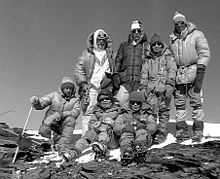Ismoil Somoni Peak
| Ismoil Somoni Peak | |
|---|---|
| Stalin Peak, Communism Peak | |
 Ismoil Somoni Peak (then known as Communism Peak) taken in 1989. | |
| Highest point | |
| Elevation | 7,495[1][2][3][4][5][6] m (24,590 ft) Ranked 50th |
| Prominence | 3,402 m (11,161 ft) Ranked 54th |
| Isolation | 279 km (173 mi) |
| Listing | Country high point Ultra |
| Coordinates | 38°56′36″N 72°00′58″E / 38.94333°N 72.01611°ECoordinates: 38°56′36″N 72°00′58″E / 38.94333°N 72.01611°E |
| Geography | |
 Ismoil Somoni Peak Location in Tajikistan | |
| Location | Northwestern Gorno-Badakhshan, Tajikistan |
| Parent range | Pamirs |
| Climbing | |
| First ascent | 3 September 1933 by Yevgeniy Abalakov and Nikolay Gorbunov. |
| Easiest route | rock/snow/ice climb |

Ismoil Somoni Peak (Tajik: Қуллаи Исмоили Сомонӣ, Qulla-i Ismō‘il-i Sōmōnî/Qullaji Ismojili Somonī; Persian: قلّهٔ اسماعیل سامانی; Russian: Пик Исмои́ла Сомони́, tr. Pik Ismoíla Somoní) is the highest mountain in Tajikistan.[1][3][7][8][9][4][5][6] Because it was within the territory of the former Russian Empire and the former Soviet Union, it was the highest mountain in the Russian Empire and Soviet Union before Tajikistan became independent. The mountain is named after Ismail Samani, a ruler of the Samanid dynasty. It is located in the Pamir Range.
Name[]
When the existence of a peak in the Soviet Pamir Mountains higher than Lenin Peak was first established in 1928, the mountain was tentatively identified with Garmo Peak.[2] However, as the result of the work of further Soviet expeditions, it became clear by 1932 that they were not the same, and in 1933 the new peak, in the Academy of Sciences Range, was named Stalin Peak[8][9] (Russian: Пик Ста́лина, tr. Pik Stálina), after Joseph Stalin. In 1962, as part of Khrushchev's nationwide de-Stalinization process, the name was changed to Communism Peak (Tajik: Пики Коммунизм, romanized: Piki Komunizm Russian: Пик Коммуни́зма, tr. Pik Kommunízma), a name by which it is still commonly known. The name Communism Peak was officially dropped in 1998 in favour of the current name, commemorating the 9th-10th century Samanid emir, Ismail Samani.[citation needed]
History[]
The first ascent (to the then Stalin Peak) was made 3 September 1933 by the Soviet mountaineer Yevgeniy Abalakov.[10]
See also[]
- Lenin Peak
- Peak Korzhenevskaya
- Mount Garmo
- Patkhor Peak
- List of elevation extremes by country
- Extreme points of Tajikistan
References[]
- The Free Dictionary: Imeni Ismail Samani Peak
- ^ Jump up to: a b "Territorial and border issues". Ministry of Foreign Affairs of the Republic of Tajikistan. 1 March 2010. Retrieved 31 January 2020.
The lowest spot of the country is on the height of 300 meters and the highest spot is on the height of 7495 meters above sea level.{...}on the South-East - Pamir (one of the highest spot of the Earth - peak Somoni, with the height of 7495 meters)
- ^ Jump up to: a b Scheffel, Richard L.; Wernet, Susan J., eds. (1980). Natural Wonders of the World. United States of America: Reader's Digest Association, Inc. pp. 104. ISBN 0-89577-087-3.
- ^ Jump up to: a b "General information about Tajikistan". Conference on Interaction and Confidence-Building Measures in Asia. Retrieved 31 January 2020.
Tajikistan is a typical mountainous country with absolute heights from 300 to 7495 m. 93% of its territory is occupied by mountains belonging to the highest mountain systems of Central Asia—Tien-Shan and Pamir. Many peaks in Tajikistan are among the highest in the world, rising to a maximum of 7,495m (24,590ft) at Ismoil Somoni Peak (formerly Peak Communism).
- ^ Jump up to: a b "TAJIKISTAN". The World Factbook. Retrieved 30 January 2020.
highest point: Qullai Ismoili Somoni 7,495 m{...}Geography - landlocked; highest point, Qullai Ismoili Somoni (formerly Communism Peak), was the tallest mountain in the former USSR
- ^ Jump up to: a b Sally N. Cummings, ed. (2010). Symbolism and Power in Central Asia: Politics of the Spectacular. Routledge. p. 67. ISBN 978-0-415-57567-6 – via Google Books.
IN 1933 THE USSR'S HIGHEST MOUNTAIN, PEAK STALIN ((7,495 m), subsequently renamed Peak Communism and ultimately Ismail Somoni) was climbed as part of a large expedition, the Tajikistan-Pamirs-expedition (TPE).{..}Mount Stalin was the highest point in the USSR
- ^ Jump up to: a b Martin Hannan (27 October 2011). Harvey Wallbangers and Tam O'Shanters A Book of Eponyms. pp. 45–46. ISBN 9781843588696.
ISMOIL SOMONI PEAK Formerly Stalin Peak and Communism Peak, the highest mountain in the former Soviet Union territories is now called after Ismoil Somoni or Ismail Samani (d. 907), leader of the Samani dynasty which conquered the region now known as the country of Tajikistan in which the mountain rises to a heigh of 7,495m (24,590 ft).
- ^ Stephen K. Batalden, Sandra L. Batalden (1997). The Newly Independent States of Eurasia Handbook of Former Soviet Republics (2 ed.). Oryx Press. ISBN 0-89774-940-5 – via Internet Archive.
Highest elevation
CS1 maint: uses authors parameter (link)
24,590 ft (Kommunizm Peak, in the Pamir Range) - ^ Jump up to: a b USSR A Reference Book of Facts and Figures. London: Farleigh Press Ltd. 1956. p. 16 – via Internet Archive.
The tallest peaks (in feet above sea-level):
Stalin Peak (Pamirs) 24,583; - ^ Jump up to: a b V. H. Hillyer and E. G. Huey (1966). The Orient. New York: Meredith Press. p. 102 – via Internet Archive.
The highest peak, Stalin Peak, 24,590 feet, is here.
CS1 maint: uses authors parameter (link) - ^ The Great Soviet Encyclopaedia. Communizma Peak. Also Pik Kommunzma at summitpost.org accessed 3Nov2016.
External links[]
 Media related to Ismail Samani Peak at Wikimedia Commons
Media related to Ismail Samani Peak at Wikimedia Commons- "Pik Kommunizma". SummitPost.org.
- "Ismoil Somoni Peak". Peakware.com. Archived from the original on 2016-03-04.
- Mountains of Tajikistan
- Seven-thousanders of the Pamir
- Highest points of countries
- De-Stalinization
